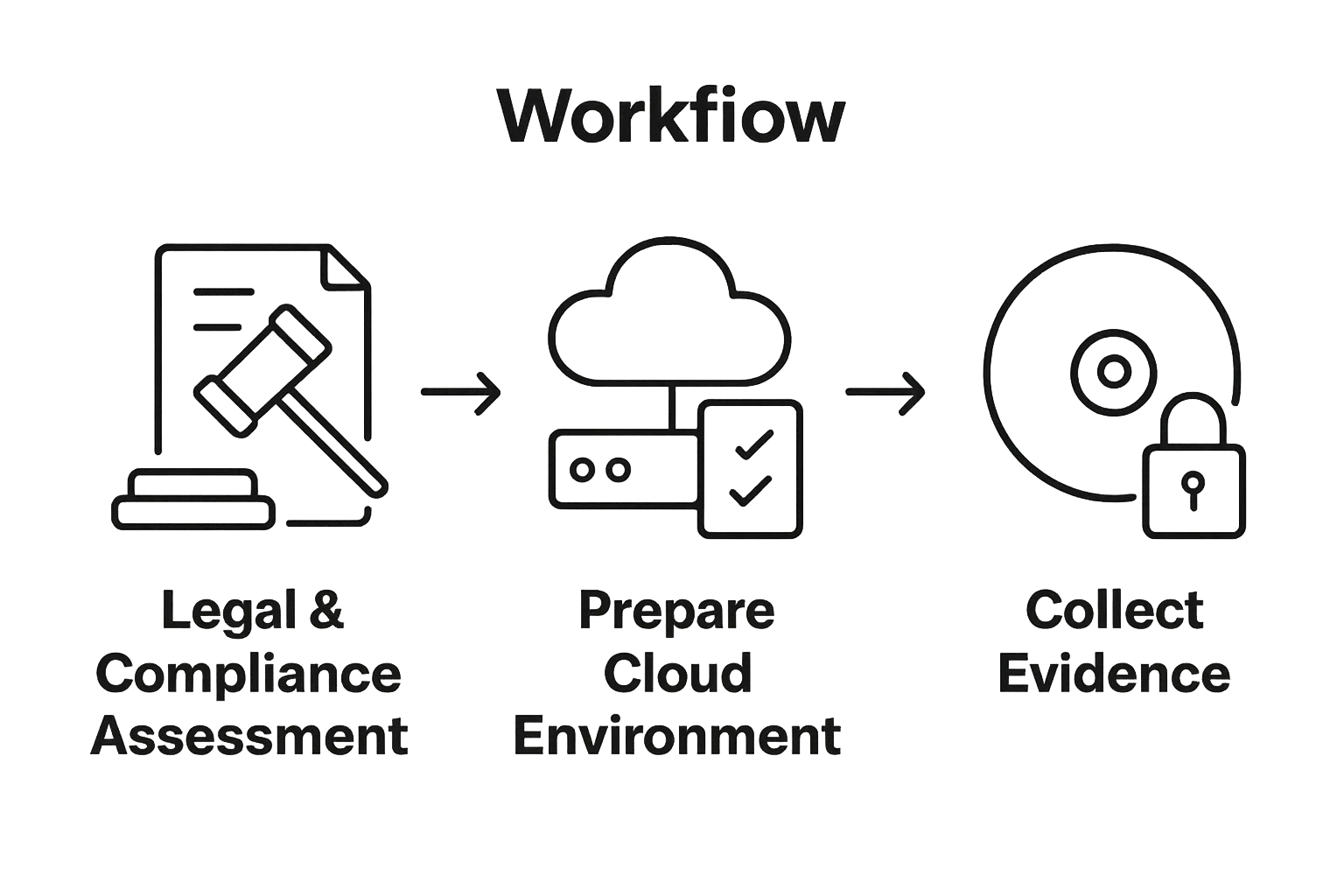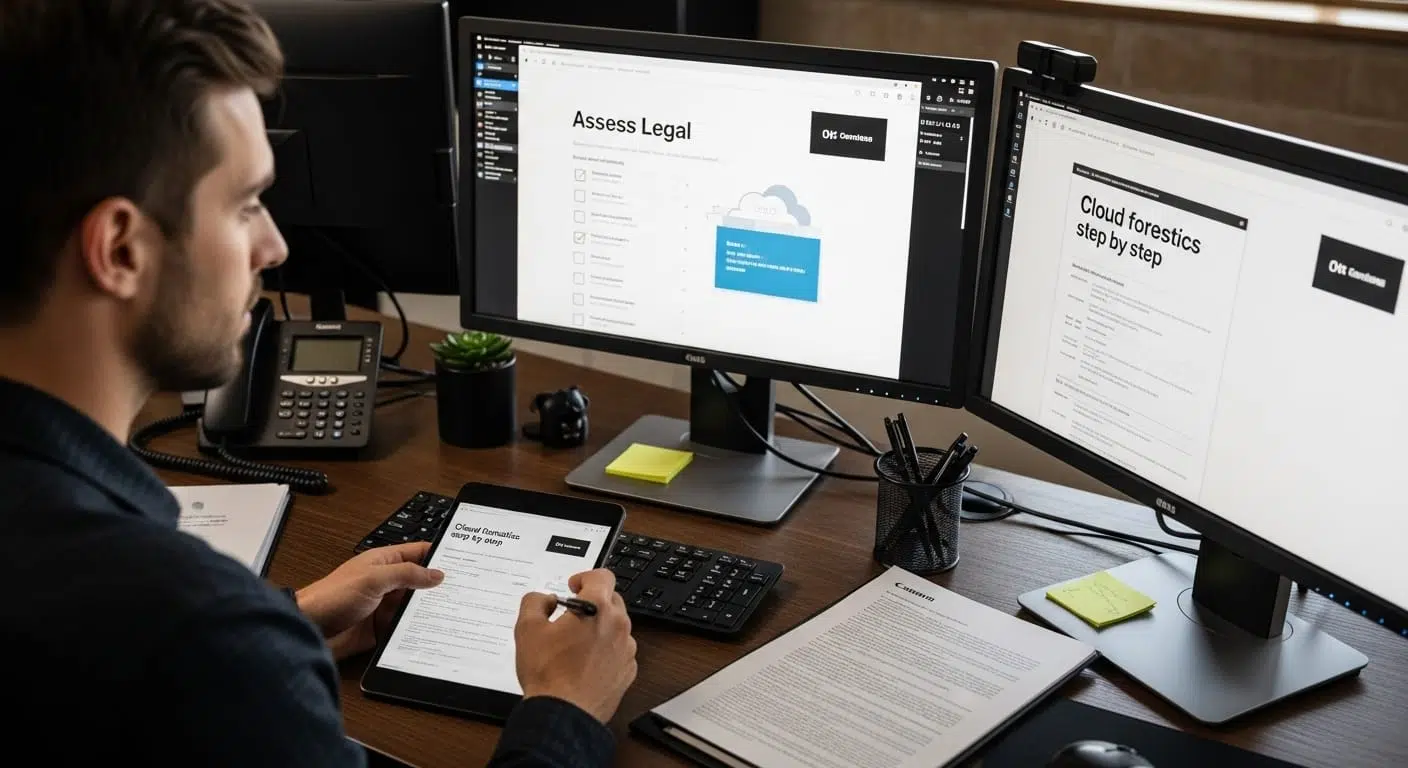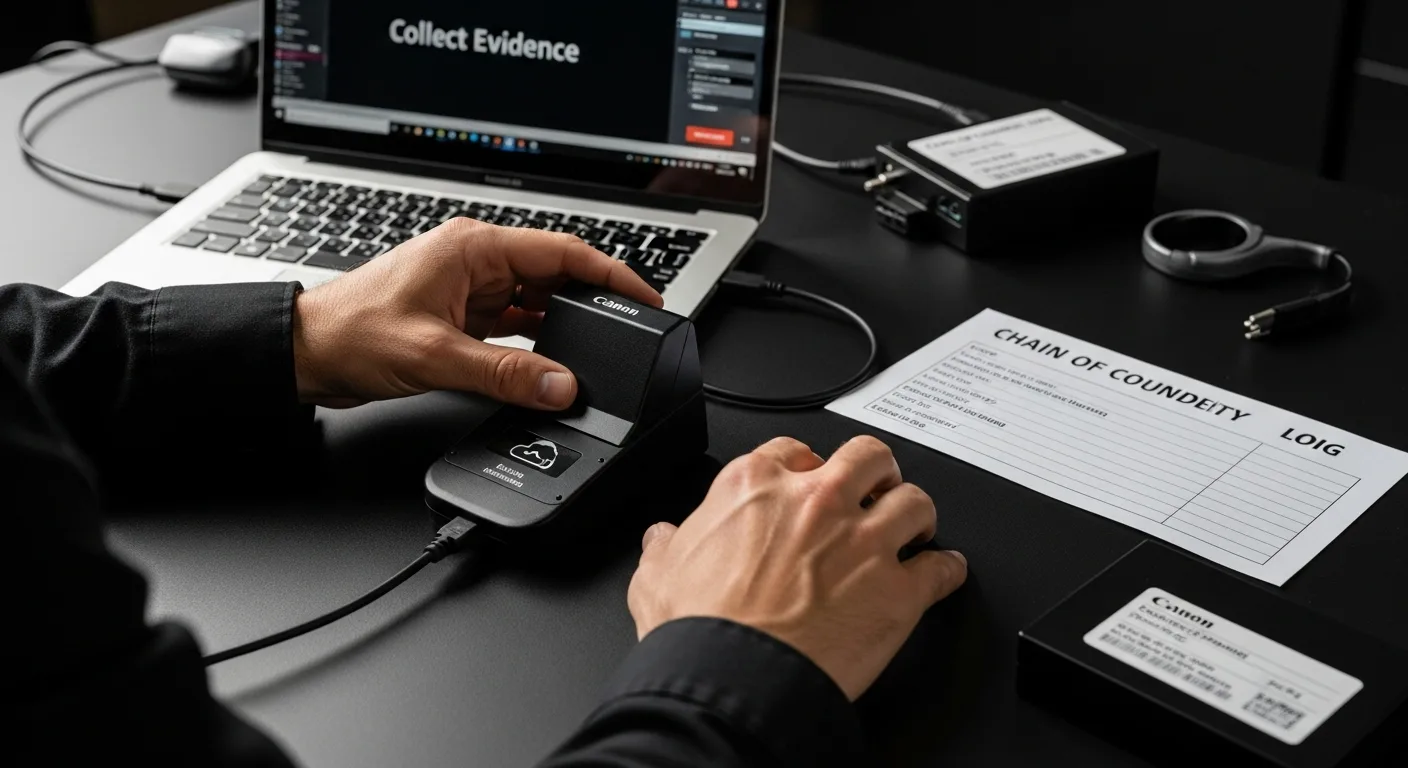Cloud forensics has quickly become a cornerstone of modern investigations as digital crime soars and data vanishes across international borders. Yet despite the growing need for cloud expertise, most forensic investigations still stumble at the basics. The surprise is that overlooking jurisdictional law can instantly make evidence unusable in court, with key statutes like the Data Protection Act and Computer Misuse Act dictating what you can and cannot collect in the UK. So before any spectacular technical wizardry begins, mastering these legal ground rules actually decides if your entire case will stand up—or collapse—long before a single byte is examined. In this context, the most popular platforms for cloud forensics, can include Office 365, One Drive, Ms Teams, Outlook, Azure, Google WorkSpace, Gmail, Google Drive, Cloud servers, DropBox, Box and AWS cloud assets.
Table of Contents
- Step 1: Assess Legal And Compliance Requirements
- Step 2: Identify And Prepare Cloud Environments
- Step 3: Collect And Preserve Digital Evidence
- Step 4: Analyse Collected Data For Forensic Insights
- Step 5: Document Findings And Prepare Reports
- Step 6: Conduct Quality Checks And Verify Results
Quick Summary
| Key Point | Explanation |
|---|---|
| 1. Understand Legal Jurisdictions | Knowledge of legal frameworks is crucial for admissible evidence in cloud forensics. |
| 2. Map Cloud Infrastructure Thoroughly | Detailed preparation of cloud architecture aids effective evidence collection and analysis. |
| 3. Ensure Chain of Custody | Maintain meticulous records to demonstrate evidence integrity through the investigation process. |
| 4. Use Forensically Sound Evidence Collection | Employ write-blocking technologies to preserve original data during evidence acquisition. |
| 5. Conduct Comprehensive Quality Checks | Validate evidence integrity and analytical methods to ensure reliable forensic findings. |
Step 1: Assess Legal and Compliance Requirements
Cloud forensics begins with a critical foundation: understanding the complex legal and compliance landscape that governs digital investigations and cloud forensics. This initial step requires meticulous preparation and strategic planning to ensure all evidence collected will be admissible and legally defensible in cloud forensics.
Understanding Jurisdictional Frameworks
Navigating the legal requirements for cloud forensics demands comprehensive knowledge of relevant legislation and regulatory standards. Different jurisdictions have unique rules governing digital evidence collection, data privacy, and investigative procedures. Legal frameworks such as the Data Protection Act and the Computer Misuse Act in the United Kingdom provide critical guidelines for forensic professionals.
Investigators must carefully examine several key aspects during this assessment phase. First, determine the specific legal jurisdiction where the data is stored and where the investigation will be conducted. Cloud services often operate across multiple geographical boundaries, which can significantly complicate evidence collection protocols. According to the NIST Cloud Computing Forensic Reference Architecture, forensic practitioners must validate their collection methods against local and international legal standards.
Compliance and Evidence Preservation
Preparing for cloud forensics requires establishing a robust compliance strategy that protects the integrity of digital evidence. This involves developing clear documentation processes, maintaining strict chain of custody protocols, and ensuring all investigative actions are meticulously recorded. Forensic professionals must obtain necessary legal authorisations, such as search warrants or explicit consent from data owners, before initiating any evidence collection.
One of the key verification steps include confirming you have cloud forensics expertise for effectively navigating the challenges of digital investigations.

- Identified all applicable legal jurisdictions
- Obtained necessary legal authorisations
- Documented precise investigative boundaries
- Established chain of custody procedures
- Verified compliance with data protection regulations
Successful completion of this step ensures that subsequent forensic actions will withstand potential legal scrutiny and maintain the evidentiary value of collected digital information.
The following checklist table summarises the key verification steps to ensure legal compliance and robust evidence preservation during the initial assessment in cloud forensic investigations.
Understanding the principles of cloud forensics is vital for investigators.
| Verification Step | Purpose |
|---|---|
| Identify applicable legal jurisdictions | Ensures compliance with geographical laws and regulations |
| Obtain necessary legal authorisations | Confirms lawful access to digital evidence |
| Document precise investigative boundaries | Defines scope and prevents overreach during evidence gathering |
| Establish chain of custody procedures | Maintains traceability and integrity of evidence |
| Verify compliance with data protection regulations | Ensures data handling aligns with statutory requirements |
Step 2: Identify and Prepare Cloud Environments
Identifying and preparing cloud environments represents a pivotal stage in digital forensic investigations, where precise mapping and strategic planning converge to establish a robust investigative foundation. This step transforms the abstract legal framework established previously into a concrete operational strategy for evidence collection.
In cloud forensics, identifying data sources accurately is crucial.
Cloud Architecture Mapping
Forensic professionals must conduct a comprehensive analysis of the cloud infrastructure, which involves meticulously documenting the intricate network of cloud services, storage systems, and computational resources. Understanding the specific cloud deployment model – whether public, private, hybrid, or multi-cloud – becomes crucial for developing targeted forensic approaches. Each cloud environment presents unique challenges and requires tailored investigative techniques.
According to the National Institute of Justice forensic guidelines, practitioners need to create detailed system inventories that capture critical information about cloud resources. This includes identifying service providers, mapping network configurations, and understanding data storage architectures. Investigators must precisely document the logical and physical structures of cloud environments, capturing details such as IP addresses, user access logs, network topology, and potential data repositories.
Forensic Readiness Preparation
Preparing for potential investigations demands establishing robust forensic readiness protocols. This involves configuring logging mechanisms, ensuring comprehensive data retention capabilities, and verifying the compatibility of forensic tools with the specific cloud infrastructure. Practitioners should develop strategies for preserving data integrity, creating secure evidence collection pathways, and maintaining comprehensive audit trails.
Cloud forensics demand a comprehensive understanding of evidence preservation methods.
Key verification steps include confirming you have:
- Mapped complete cloud infrastructure topology
- Documented all service provider configurations
- Established comprehensive logging mechanisms
- Verified forensic tool compatibility
- Created secure evidence collection protocols
Successful completion of this step transforms abstract cloud environments into structured, investigative-ready landscapes, positioning forensic professionals to efficiently navigate and extract critical digital evidence.
This checklist table provides an at-a-glance summary of essential actions for preparing cloud environments, ensuring all necessary forensic readiness steps are completed before evidence collection begins.
Effective cloud forensics practices require thorough documentation of processes.
| Preparation Step | Description |
|---|---|
| Map complete cloud infrastructure topology | Understand all relevant systems and network connections |
| Document all service provider configurations | Record provider details and environment settings accurately |
| Establish comprehensive logging mechanisms | Ensure activity is captured for audit and investigation purposes |
| Verify forensic tool compatibility | Confirm tools fit the specific cloud environment |
| Create secure evidence collection protocols | Protect integrity and confidentiality during evidence acquisition |
Step 3: Collect and Preserve Digital Evidence
Collecting and preserving digital evidence represents a critical juncture in cloud forensics, where investigators transform potential data into legally admissible documentation. This intricate process demands precision, technical expertise, and unwavering attention to procedural integrity.
Evidence Acquisition Strategies
Forensic professionals must employ sophisticated techniques to extract digital evidence while maintaining its original state and preventing potential contamination. Forensic investigators must create exact, bitwise copies of digital artifacts using write-blocking technologies to ensure the original data remains unaltered. Cloud environments introduce unique challenges, requiring specialised approaches that differ from traditional digital forensics.
According to the NIST Cloud Computing Forensic Reference Architecture, collecting cloud evidence necessitates a methodical approach that encompasses multiple layers of data extraction. This involves capturing volatile data, system logs, network traffic, and static data storage elements. Investigators must carefully document each step of the collection process, generating comprehensive forensic images that can withstand legal scrutiny.
Chain of Custody Preservation
Maintaining an unbroken chain of custody becomes paramount when collecting digital evidence from cloud environments. Every interaction with potential evidence must be meticulously recorded, demonstrating a clear, uninterrupted pathway from initial discovery through forensic analysis. This requires creating detailed logs that track who accessed the evidence, when, and under what circumstances.
Key verification steps include confirming you have:
- Generated forensically sound bit-by-bit evidence copies
- Documented comprehensive acquisition procedures
- Established verifiable chain of custody records
- Validated evidence integrity through cryptographic hashing
- Secured original and forensic copy evidence repositories
Successful completion of this step transforms raw digital data into structured, legally defensible evidence, preparing the groundwork for subsequent in-depth forensic analysis.
Mastering cloud forensics techniques is essential for successful investigations.
The table below summarises key verification steps to follow during collection and preservation of digital evidence in the cloud, helping ensure the integrity and admissibility of collected data.
| Verification Step | Purpose |
|---|---|
| Generate forensically sound bit-by-bit copies | Preserve the original state of digital artefacts |
| Document comprehensive acquisition procedures | Create a full record of all collection actions |
| Establish verifiable chain of custody records | Demonstrate a clear history of evidence handling |
| Validate evidence integrity through cryptographic hashing | Confirm data has not been altered |
| Secure original and forensic copy evidence repositories | Prevent unauthorised access or tampering |
Step 4: Analyse Collected Data for Forensic Insights
Utilising cloud forensics helps in uncovering vital digital evidence.
Analysing collected data represents the intellectual core of digital forensic investigations, transforming raw digital artifacts into meaningful narrative evidence. This critical stage demands a sophisticated blend of technical expertise, analytical thinking, and systematic investigation techniques that uncover hidden patterns and digital footprints.
Forensic Data Processing
Forensic data analysis requires a structured, methodical approach that deconstructs complex digital ecosystems into comprehensible investigative elements. Investigators must employ advanced technological tools and forensic software capable of parsing through massive volumes of cloud-based data. This involves utilising specialised forensic platforms that can reconstruct timelines, extract metadata, recover deleted files, and trace digital interactions across multiple cloud platforms.
According to the National Institute of Justice guide, forensic professionals must systematically examine digital evidence by establishing contextual relationships between data points. This means correlating timestamps, tracking user activities, identifying potential anomalies, and understanding the intricate connections between different digital artifacts. Advanced forensic techniques might include steganography analysis, network traffic reconstruction, and cryptographic examination of suspicious files.
Investigative Insight Generation
The insights gained from cloud forensics can significantly impact case outcomes. Transforming raw data into actionable intelligence requires forensic experts to move beyond mere technical analysis. Investigators must develop narrative frameworks that interpret digital evidence within broader contextual scenarios. This involves connecting seemingly disparate digital fragments to construct comprehensive investigative narratives that can withstand legal and technical scrutiny.
Key verification steps include confirming you have:
- Processed all collected digital evidence systematically
- Reconstructed comprehensive digital timelines
- Identified and isolated potential evidentiary artifacts
- Generated detailed forensic analysis reports
- Cross-referenced multiple data sources for verification
Successful completion of this step translates complex digital information into clear, compelling investigative insights that can support legal proceedings, organisational security assessments, or criminal investigations.
Step 5: Document Findings and Prepare Reports
Documenting findings and preparing comprehensive forensic reports represents the final critical transformation of digital evidence into a structured, legally defensible narrative. This step bridges technical investigation with legal comprehension, translating complex digital forensic discoveries into clear, precise documentation that can withstand judicial scrutiny.
Forensic Reporting Methodology
Creating a forensic report demands meticulous attention to detail, scientific precision, and clear communication of technical findings. Investigators must construct reports that are simultaneously technical and accessible, ensuring that both technical and non-technical audiences can understand the investigative process and conclusions. This involves developing a structured narrative that chronologically presents evidence, methodologies employed, and substantive findings while maintaining absolute objectivity.
According to the NIST Cloud Computing Forensic Reference Architecture, forensic documentation must include comprehensive details about evidence collection, preservation techniques, analytical methodologies, and explicit conclusions. The report should provide a transparent, reproducible account of the investigation that allows independent verification of the forensic process.
Evidence Presentation and Validation
Forensic professionals must present their findings in a manner that establishes clear provenance, demonstrating the integrity of collected evidence and the reliability of investigative techniques. This requires creating detailed documentation that includes forensic tool outputs, hash values, acquisition timestamps, and explicit descriptions of analysis procedures. The report must anticipate potential legal challenges by providing comprehensive, unambiguous documentation of every investigative step.
Key verification steps include confirming you have:
- Documented complete investigative methodology
- Generated comprehensive forensic reports
- Included all relevant technical and evidentiary artifacts
- Validated report accuracy and completeness
- Prepared supplementary exhibits and evidence logs
Successful completion of this step transforms raw digital investigation into a structured, legally admissible narrative that can support judicial proceedings, organisational investigations, or cybersecurity assessments.
Step 6: Conduct Quality Checks and Verify Results
In cloud forensics, thorough validation processes enhance evidence reliability.
Quality checks and result verification represent the final safeguard in cloud forensic investigations, ensuring the reliability, integrity, and scientific validity of digital evidence. This critical step transforms investigative findings from preliminary assessments into legally robust, defensible documentation that can withstand rigorous judicial and technical scrutiny.
Forensic Evidence Validation
Forensic professionals must implement comprehensive validation protocols that systematically examine every aspect of the digital investigation. This involves cross-referencing multiple data sources, verifying evidence integrity through cryptographic hashing, and confirming the reproducibility of analytical techniques. Investigators must meticulously validate each digital artifact, ensuring that the extraction and analysis processes have not inadvertently modified or compromised the original evidence.
According to the National Institute of Standards and Technology’s Federated Testing Project, forensic tool validation requires employing standardised testing environments and comprehensive documentation templates. This process involves running multiple verification scenarios, comparing results across different forensic platforms, and documenting any discrepancies or potential limitations in the investigative methodology.
Systematic Result Verification
Verifying forensic results demands a structured approach that goes beyond simple data confirmation. Investigators must reconstruct digital timelines, validate evidence provenance, and ensure that all investigative conclusions are supported by empirical evidence. This involves creating independent verification pathways that allow other forensic professionals to replicate the investigation and arrive at similar conclusions.
Key verification steps include confirming you have:
- Validated evidence integrity through cryptographic methods
- Cross-referenced multiple data sources
- Documented all verification procedures
- Confirmed reproducibility of forensic techniques
- Identified and addressed potential investigative limitations
Successful completion of this step transforms raw digital investigation into a scientifically validated, legally defensible narrative that meets the highest standards of forensic excellence.
Facing Cloud Investigation Complexities? Get Expert Forensic Support
Establishing robust legal compliance, preserving digital evidence integrity, and ensuring a watertight chain of custody are the biggest challenges identified in your cloud forensic process. Navigating technical complexity and legal hurdles can leave you worrying about incomplete investigations or overlooked digital evidence. If safeguarding evidence quality and building a case-ready report are your concerns, you are not alone. Secure your investigations by relying on specialist digital forensics support.
Engaging experts in cloud forensics can mitigate investigation complexities.
At Computer Forensics Lab, our experienced team translates the framework in this article—chain of custody, legal validation, cloud data mapping, and quality checks—into results for law firms, businesses, and private clients pursuing digital truth. Whether you need advanced cloud evidence collection, rigorous forensic analysis, or expert witness testimony, our service helps you overcome the most complex technical and legal barriers. Do not leave your digital investigation to chance. Discover how our digital evidence collection service can strengthen your case today. Contact us now to ensure your cloud investigation is both defensible and complete.
Frequently Asked Questions
What are the legal considerations in cloud forensics?
Understanding legal considerations in cloud forensics involves grasping jurisdictional frameworks, applicable legislation, and data protection regulations. Investigators must secure necessary legal authorisations, and document all processes to ensure evidence is admissible in court.
How do I prepare cloud environments for forensic investigations?
Preparing cloud environments involves mapping the cloud architecture, including documenting service configurations and establishing logging mechanisms. Forensic readiness protocols should also be implemented to ensure data integrity and secure evidence collection pathways.
What strategies should be used for collecting digital evidence from the cloud?
Digital evidence collection requires sophisticated techniques such as creating bitwise copies of digital artifacts using write-blocking technologies. It’s crucial to document each step of the evidence collection process, ensuring that everything is done in a legally defensible manner.
How can I ensure the integrity of digital evidence during analysis?
Implementing best practices in cloud forensics is crucial for data integrity.
To ensure the integrity of digital evidence, forensic professionals must implement validation protocols that cross-check multiple data sources, use cryptographic hashing to verify evidence, and document all verification procedures to maintain a clear chain of custody.
Since 2007, Computer Forensics Lab has been involved in digital forensics investigations across a wide range of cases. Our digital forensics experts have many years of experience preparing expert reports and attending court throughout the UK. For confidential assistance, call 02071646915 or use our secure service inquiry form.
Recommended
Staying updated on cloud forensics trends can enhance investigative success.

